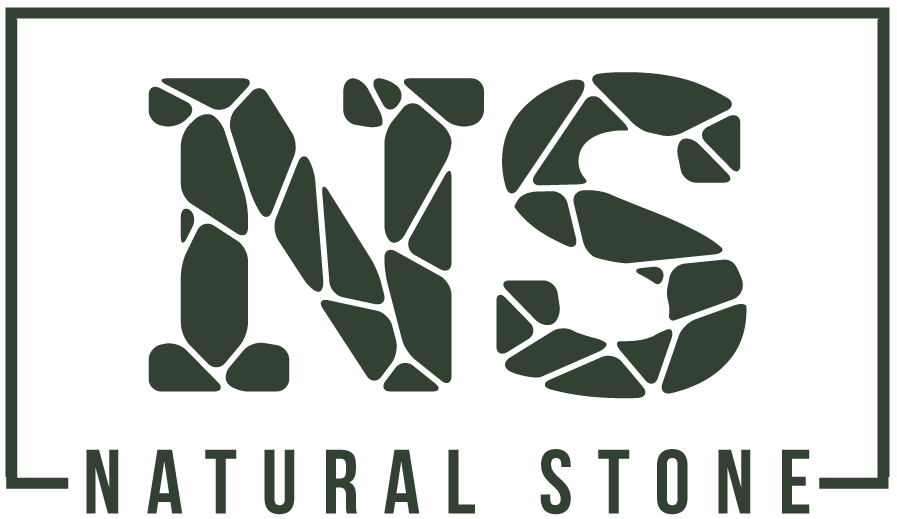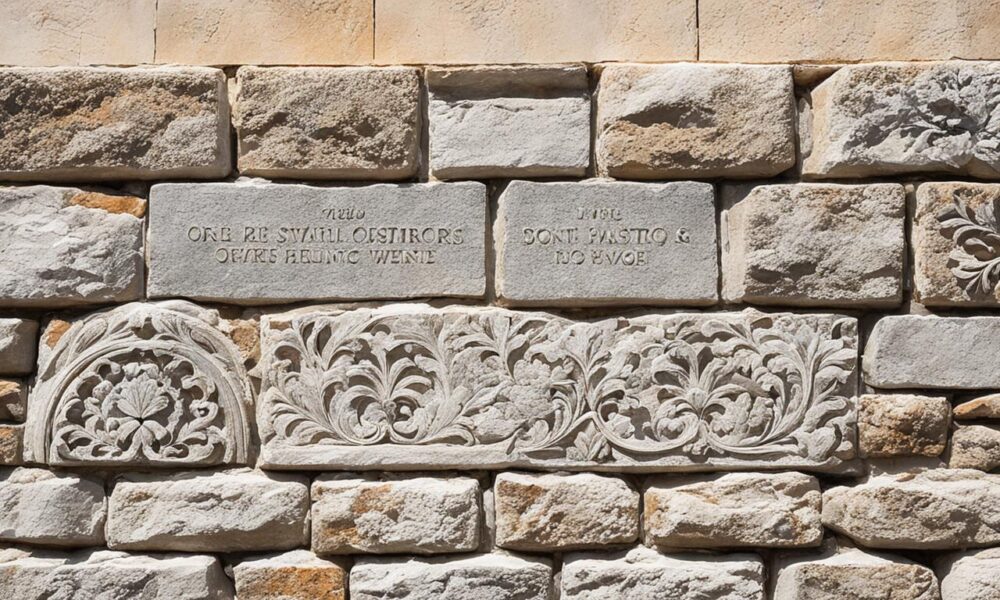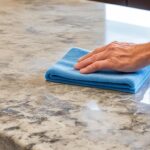Restoring Old Stone: Your Natural Stone Guide
Restoring old stone, known as stone rejuvenation, involves polishing to show a new layer. This keeps the stone’s beauty and function. The process may have up to 8 stages. It starts with fixing poorly laid tiles and removing marks1.
Whether fixing old stone or enhancing a newer one, the right restoration can fix installation mistakes or change the finish.
Resurfacing stone floors uses diamonds on a heavy machine, handling many finishes1. This method makes old stone look great and work well for any place.
Regular care is key for keeping natural stone in top shape. Treatments harden the stone, preventing scratches and moisture1. Doing this keeps the stone beautiful for a long time.
Key Takeaways
- Restoring old stone includes grinding and polishing1.
- You can get different looks like honed or shiny based on what you like1.
- Rejuvenation fixes mistakes from when the stone was put in and can change its look1.
- Keeping up with professional care helps keep natural stone looking good1.
- Densifying compounds protect the stone from scratches and moisture1.
Introduction to Natural Stone Restoration
Natural stone restoration is a way to make stone surfaces look like new again. It uses different techniques to fix and refresh old and new stone. The aim is to fix damage and keep stone looking good and working well.
What is Natural Stone Restoration?
Natural stone comes in three types: sedimentary, metamorphic, and igneous2. Restoration often fixes common problems. These include etching from acids and cracks from sudden temperature changes3. Techniques like grinding, polishing, and sealing restore the stone’s original look3. It’s also important to know if a stone is calcareous or siliceous to choose the best restoration method2.
Importance of Professional Restoration
It’s key to use professional stone restoration to keep the stone’s integrity. Look for companies with great reviews, fair prices, and the right expertise3. These experts use the best cleaning and restoration methods for each type of stone. This includes fixing etches and reducing damage from thermal shock3.
Since 1855, specialist restorers have built a deep knowledge of preventing stone damage4. Going for professional stone restoration means the stone stays strong and looks great over time. No matter the project, expert restorers can handle all repair needs specifically tailored to each stone surface.
Common Types of Stone Damage
Stone surfaces can face many kinds of damage. Each type needs a special way to fix it. Knowing the problems is key to fixing stone the right way.
Stains are common on natural stone. They can come from oil, rust, water, and some foods. Water stains happen a lot. They’re caused by liquid building up, which makes the stone look dull and discolored3. Cleaning stone often helps avoid stains. This is really important for stones like limestone and sandstone. They can erode more easily5.
Scratches and Hit Marks
Fixing scratches on stone is important to keep it looking good and strong. Walking and scratchy things can scratch the surface. Heavy items being dragged can make deeper scratches. Sudden hits can cause white marks on or inside the stone3. Being careful and using protection can stop these damages.
Cracks and Extreme Temperature Damage
Cracks in stone are a big problem. Bad installation, poor materials underneath, or tree roots growing under the stone can cause them3. Moisture is bad for stone too. It can freeze and cause cracks, layers to split apart, and other problems5. Damage from very hot or cold temperatures depends on how porous the stone is and its base stability3. The right installation and managing the environment can lower these risks.
When to Consider Stone Restoration
Knowing when to restore stone can prevent big repairs later. Look for signs like dullness, scratches, and unevenness. These signs mean your stone could need help.
This early action keeps the stone’s beauty and usefulness.
Factors Indicating the Need for Restoration
Several signs show stone needs fixing. These include scratches, stains, and etching. Restoration might require up to 8 steps1.
This is true for both old and new stones1. Using diamond abrasives makes the surface smooth1. Most times, experts can make the stone look new again3.
Benefits of Early Restoration
Fixing stone early has many advantages. It stops more damage and saves money and effort. Getting to it before it gets worse keeps the stone looking great.
Applying a special compound makes the stone harder and less likely to get scratched1. How often the stone needs maintenance depends on its use and people walking on it1.
Having an expert work on your stone from the start means it will last longer6.
Restoring Old Stone: A Guide to Natural Stone, Restoration
Effective old stone renovation begins by knowing the stone’s unique features and the right restoration ways for each type. Stones are divided into siliceous ones like granite and calcareous ones such as marble7. Every kind needs a particular kind of care and techniques for restoration. A full restoration guide covers resurfacing steps, including up to 8 different methods1.
Resurfacing old stone surfaces uses high-tech tools like a heavy rotary machine for a full grind to polish1. A densifier helps lower moisture absorption and boost scratch resistance, vital for stone care1. It’s key to pick restoration products like Edison Coatings’ Custom System 45 for better bond strength and less shrinkage8.
For historic places, matching materials with the original is key. Rosendale 11G grouts work well with 19th-century masonry8. Thus, successful restoration blends new methods with proven materials. Groups like the Marble Institute of America (MIA) provide valuable resources, including publications and seminars7.
After restoring, follow ASTM C1515-01 standards advised by MIA to keep benchmarks7. Maintenance depends on how much a room is used and its traffic1. Keeping stone surfaces well-maintained lowers the need for heavy future care, protecting the stone’s look and strength1.
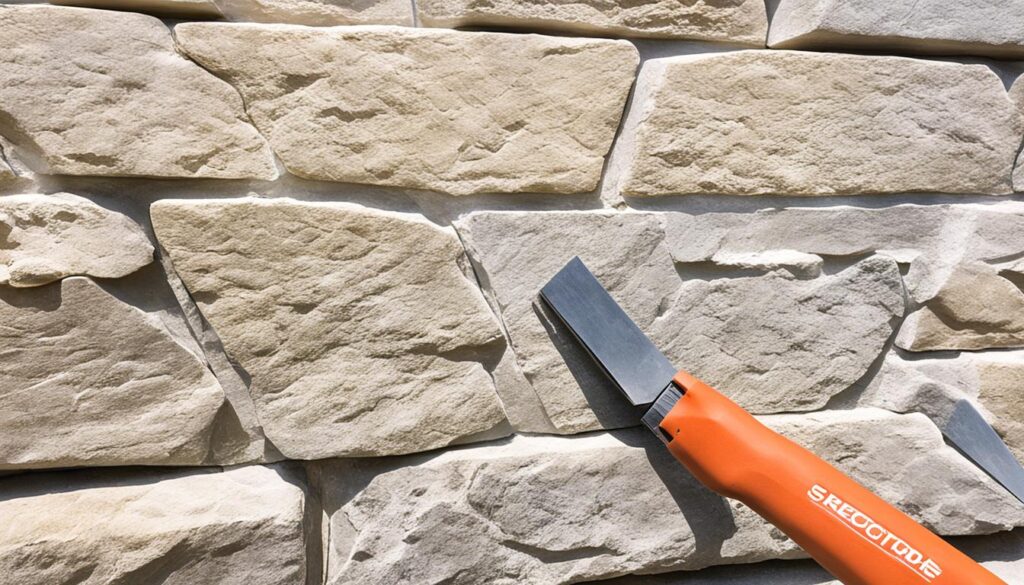
In summary, restoring old stone well demands a deep grasp of different stones and their needs. Using old and new restoration ways ensures that the work meets beauty and structure goals. It highlights the value of knowing a lot from a complete stone restoration guide.
Step-by-Step Stone Restoration Process
Restoring stone is a careful journey starting with an in-depth look. It then moves to precise fixing methods. Each phase is key for a strong and good-looking finish.
Initial Inspection and Damage Assessment
The journey begins with a detailed check and figuring out the damage. This step finds problems like stains, scratches, and cracks. It’s needed when moving into a home with stone floors or during renovations1.
Grinding and Rehoning Techniques
Then, it’s time for specialized grinding. This is done with heavy machines and resin bonded diamonds to get rid of big scratches and stains1. Rehoning makes the stone smooth, ready for further steps. This ensures a perfect base for the next stages like polishing and sealing.
Polishing and Sealing Methods
Polishing uses diamond abrasives to get the shine you want, from matte to really shiny1. Sealing protects the stone, important for marble, granite, and limestone9. Sealers, like penetrating ones, both darken and protect the stone, keeping away stains9.
Full Restoration vs. Spot Fixes
There are different ways to repair natural stone, depending on the damage. Knowing when to fully restore or just do spot fixes is key for looks and saving money.
The Comprehensive Approach of Full Restoration
Full stone restoration makes the whole surface look the same. It’s best for really scratched or uneven surfaces. It makes everything smooth and fixes any deep-seated issues.
Edison Coatings has 25 years of experience in stone restoration8. They customize their approach, like with Custom System 45, to match each stone. This ensures repairs last a long time8. Their expertise means your stone will not only last longer but look great as a whole.
When Spot Fixes Are Sufficient
Sometimes, only small areas need fixing. Spot fixes for stone are for minor problems like little scratches or chips. This method is quicker and cheaper for small fixes. Thin-Fill 55 is perfect for filling in up to ¼ inch deep
Flexi-Weld 520T glues broken stone without leaving gaps8. It shows how some repairs can be simple but effective. Spot fixes work well when the rest of the stone is still in good shape.
The choice between full restoration and spot repair depends on the damage and what you want to achieve. By understanding your stone’s needs, you can pick the best fix for a lasting result.
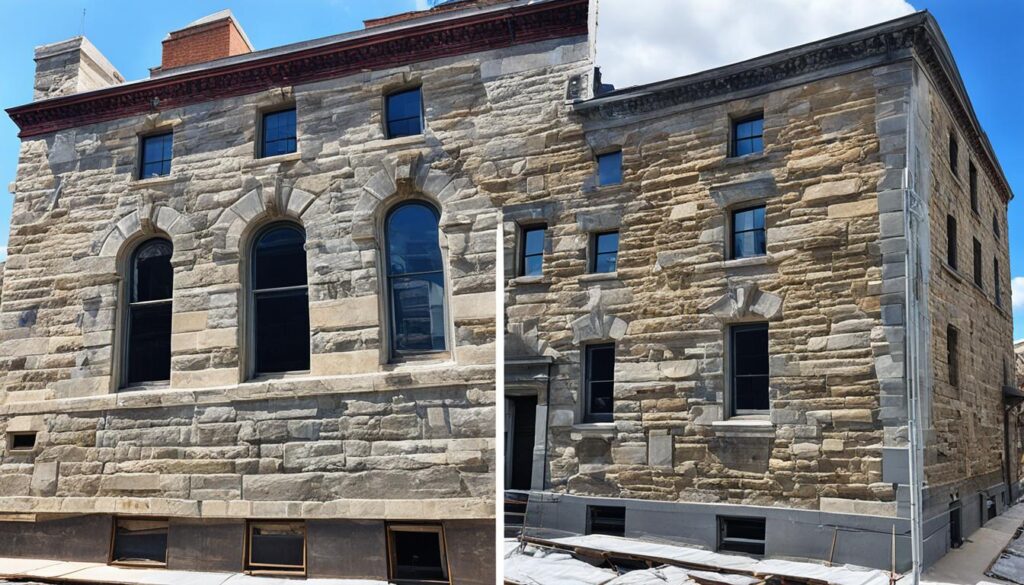
Different Finishes for Restored Stone
Restored stone surfaces can range from a matte to a highly polished look. The restoration uses diamond abrasives to refine the surface. This allows clients to choose from a honed to a shiny polish finish1.
The resurfacing of natural stone involves resin bonded diamonds and a heavy rotary machine. This machine, weighing up to 160kg, lightly abrades the stone. It removes surface scratches and etch marks1.
Stone floor restoration has up to eight stages. It starts with grinding to fix uneven tiles or deep imperfections1.
For bigger repairs, Thin-Fill 55 Reprofiling Mortar is used for easy sanding or polishing. It makes surfaces smooth and refined8. Flexi-Fill 530, another option, is less invasive and works well for cracks that don’t move much8. With these methods, finishes can be anything from matte to highly polished. They give homeowners personalized design solutions.
Tools and Materials Needed for Stone Restoration
Restoring stone surfaces needs a full set of tools and materials. This ensures the process is effective and efficient.
Essential Tools
The main tools for restoring stone are diamond grinders. They level surfaces and fix imperfections. These grinders use diamonds on a rotary machine weighing up to 160kg1. This heavy weight helps treat the stone evenly. It fixes issues like uneven tiles and deep scratches.
Polishing machines are key for a high-polish finish. They make scratch patterns finer and tighter. This makes the stone look shiny by reflecting more light1.
Recommended Supplies
Along with stone restoration tools, you’ll need specific stone refinishing materials. Use quality sealers to protect the stone from spills and wear. These sealers and densifying compounds harden the stone. This reduces moisture and scratches1.
High-grade abrasives for rehoning and polishing are important. They let you get various finishes, from matte to high polish. Choose materials that fit the stone type for best results1.
It’s crucial to know about stone restoration tools and materials. This knowledge helps keep your stone beautiful and lasting.
Common Challenges in Stone Restoration
Restoring natural stone can be rewarding yet challenging. Issues like deep cracks and dangerous materials need expert care. Knowing these problems and using the right methods makes restoration successful.
Addressing Deep Cracks
Fixing deep cracks is a big challenge in stone restoration. These cracks can come from bad installation, weak bases, or tree roots3. Stone floors might also have cracks between stones and loose stones that need careful checking and fixing10. To fix these deep cracks, extensive treatment like grinding, rehoning, and sealing is needed to make the stone strong again3.
Handling Hazardous Materials
During restoration, dealing with hazardous materials must be done carefully. Acidic chemicals, for example, can permanently damage the stone if not handled quickly3. Also, porous stones might hold bacteria that can cause mold, mildew, and health issues10. It’s essential to use protective gear and the right cleaners to prevent further damage from acid5.
Overall, overcoming stone restoration challenges like fixing deep cracks and handling hazardous materials needs skill and knowledge about the stone. Using the right strategies can help avoid problems in stone repair and lead to successful restoration.
Maintenance Tips for Preserving Restored Stone
To keep restored stone looking great, it needs regular care. The right products and methods are key. They help maintain the stone’s look and its strength.
Regular Cleaning Techniques
Clean the stone often with mild cleaners or stone soap2. Use products that won’t harm the stone. For stones like marble, avoid any cleaner with acid like lemon or vinegar2.
Use a dry, non-treated mop for dusting2. This prevents scratches. Follow the Marble Institute of America’s cleaning guide. It includes methods and how to get rid of stains according to ASTM C1515-017.
Long-Term Maintenance Strategies
For long-lasting care, seal the stone2. Sealing helps protect against spills but doesn’t make it stain-proof. This increases its resistance2.
Check your stone often to spot issues early11. Keeping track of the stone’s details helps with proper care. This approach keeps both the look and function intact11.
| Stone Maintenance Tip | Description |
|---|---|
| Regular Cleaning | Use pH-neutral products, stone soap, or mild liquid dishwashing detergent2. |
| Sealing | Apply impregnating sealers to increase stain resistance2. |
| Non-Treated Dust Mops | Dust with non-treated dry mops to avoid abrasives2. |
| Routine Inspections | Check regularly for early signs of damage11. |
Choosing a Professional Stone Restoration Service
Finding the right professional to restore your stone surfaces is key. Start by checking the company’s experience and past successes. Businesses like Edison Coatings stand out with over 25 years of expertise in restoring stone8.
Look at the variety of services they offer too. A top-notch service can fix different kinds of stone damage with special materials. For example, using Flexi-Weld 520T allows for reattaching broken stone cleanly8. Repair products like Pump-X53-Series also fill cracks without leaving stains8.
It’s wise to read customer feedback and get several quotes. The right experts understand various stone types deeply. Joining reputable organizations, like the Marble Institute of America, shows a company’s dedication to quality. This group has over 1,200 members worldwide7. Being a member means they’re committed to the industry’s highest standards7.
A reliable stone restoration service prefers fixing over replacing. They aim to make your stone look its best again. By remembering these tips, you’ll find someone to keep your stone beautiful for a long time.
Source Links
- https://athenastonecare.co.uk/everything-you-need-to-know-about-restoring-natural-stone/
- https://www.naturalstoneinstitute.org/consumers/care/
- https://stonecenters.com/blog/natural-stone-restoration-all-you-need-to-know
- https://www.szerelmey.com/wp-content/uploads/2015/09/SZ_Restoration_Guide.pdf
- https://johncanningco.com/blog/how-to-identify-and-prevent-issues-with-historic-stone/
- https://www.stamfordstone.co.uk/preserving-masonry-stone-restoration-tips-for-aging-buildings-2/
- https://smokeymountaintops.com/wp-content/uploads/2017/02/Guide-to-Care-Cleaning-of-Natural-Stone.pdf
- https://www.edisoncoatings.com/REPAIR_OF_Natural_Stone.pdf
- https://www.daltile.com/how-to/how-to-care-for-and-maintain-tile/how-to-care-for-and-maintain-natural-stone
- https://stone-guru.co.uk/the-complete-guide-to-restoring-stone-floors
- https://www.stjosephmo.gov/DocumentCenter/View/14515
